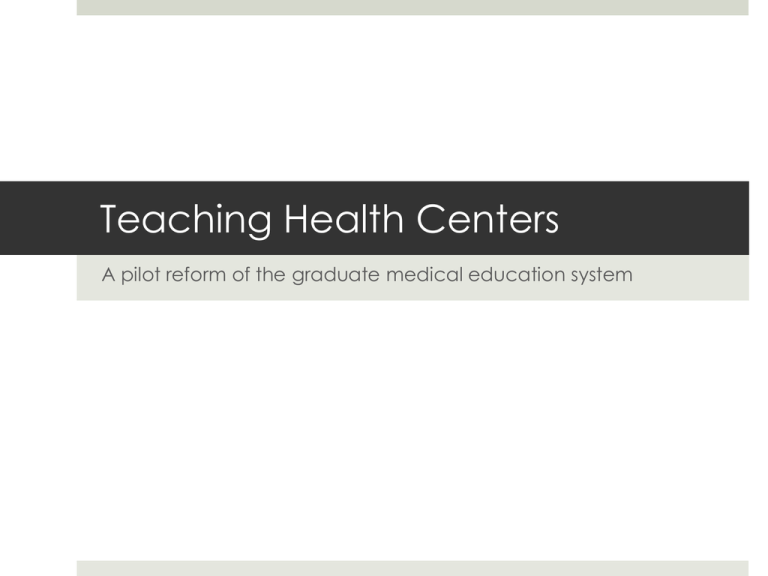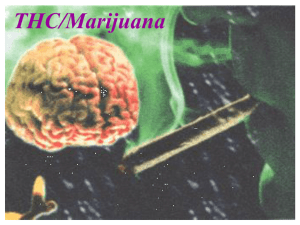Teaching Health Centers - The Robert Graham Center
advertisement

Teaching Health Centers A pilot reform of the graduate medical education system Introductions MS4 at Loyola Stritch School of Medicine in Chicago Inspired by Community Health Center (CHC) experience in 3rd year When looking for CHC-connected Family Medicine Residencies (FMRs), came across the term “Teaching Health Center” (THC) Subsequently matched at one of the “Original 11” In addition, survey of THC applicants had recently been completed, but not yet analyzed Objectives Describe the complex history of THCs Present the survey results of 2012 applicants Utilize the expertise in the room Refine survey analysis Discuss possible THC action items What is a THC? Old idea Connecting CHCs and FMRs New legislation Section 5508 of Patient Protection and Affordable Care Act (2010) Why? Origins of the CHC Movement Originated in apartheid South Africa with John Cassel and Sidney Kark Brought to the US by Jack Geiger and Count Gibson First two U.S. CHCs in Massachusetts and Mississippi delta in the 1960s CHC Principles Fusion of primary care and public health Community-based and community-driven “Epidemiological assessment of demographically defined communities, prioritization, planned interventions and evaluation” “Their commonsense holistic philosophy came from an understanding that good health is impossible if you have to choose between food, rent and medicine” Brief Political History of CHCs Initial federal adoption as a result of Ted Kennedy visiting the CHC in Boston Started under institutional partnerships, but these broke down as local communities pressed for local control Community-based board regulations enacted over presidential veto in 1975 Block grant legislation under Reagan in 1981 Reversed the legislation despite presidential veto in 1985 Largest growth under the two Bush administrations Why such legislative success? Strong community buy-in Powerful local leaders Provides concrete services where they are needed most “Only two groups of people…” CHCs Today Federal Funding of 2.6 billion annually 2 billion more from the stimulus bill and another 11 billion in PPACA 1,131 Centers with 8,000 sites serving 18 million people 70% below poverty line, another 20 % near poor 63% Minorities and 40% uninsured Studies show despite more complex and sicker patients, outcomes are better, hospital admissions lower and ER visits less Supporting Programs Federal Tort Claims Act (FTCA) 340B Drug discount program Provides 20-50% in total savings FQHC Look-alikes Graduate Medical Education (GME) The other side of the THC coin Quick Summary of GME in the U.S. First connected to Medicare in 1965 Has since become backbone of GME funding Especially for centers who lack substantial NIH support Based upon direct and indirect costs estimates Indirect being tied to inpatient care provided to Medicare recipients Positions capped per the balanced budget act (BBA) in 1977 Fiscal Year (FY) 2009 Fund distribution 9.5 billion from Medicare 3.2 billion from Medicaid 800 million from Veteran’s Affairs (VA) Common Critiques of GME Payments have limited relationship to costs Minimal Accountability Financial incentives for inpatientbased and subspecialty programs—since BBA: 46 FM programs closed 133 subspecialty fellowships opened Unable to match specialty mix and geographic distribution with population needs Who Loses? Connecting GME back to CHCs Since 1996, a 52.6% decrease in US Med students going into Family Medicine Currently, 31% of total MDs practice primary care And only 25% of grads are planning to do it National Association of Community Health Centers (NACHC) projects an additional 15,000 providers will be needed to cover their patients by 2015 In perspective—for 2011: 25,020 residents matched, with 2,555 in FM CHC-FMR Partnerships: A Possible Solution? Not a new idea at all (original CHCs had visiting residents) But, has been formalized and institutionalized with mixed results Natural partnership Common commitments, increased sustainability, strong educational environment, and improved patient outcomes But, significant challenges Contrasting missions, chronic underfunding of both parties, and asynchronous governing bodies with vastly different oversight regulations Section 5508 of the PPACA The first “Teaching Health Centers” Section 5508 at a Glance 230 million for FY 2011-2015 For primary care GME programs based out of a health center Not required to be a FQHC or look-alike First awards given in January 2011 to 11 of the 24 programs that applied In 2012, 11 more recipients selected giving total of 22 THCs Will not reach $230 million cap without significant further expansion Central impact: GME funds given directly to outpatient site and with significantly increased accountability measures The “Original 11” 9 FM, one IM, one Dentistry 6 of 11 directors run CHC and FMR 5 include rural training All 11 use EMR and are either FQHC or FQHC-look alikes Survey Results 2012 Interviewees of THCs Methods Population studied: All applicants that received interviews a THC for 2012 549 surveys sent, with 282 responses 51% response rate Some items written to mirror other common survey results Graduation Questionnaire (GQ) ERAS and NMRP data Birth by State Foreign CA NY TX WA MA PA IL MN NJ CO OH 90 34 19 13 12 10 8 7 7 7 6 6 High School by State Foreign CA NY TX WA MA PA FL IL OH MI NJ 58 53 17 13 13 12 8 7 7 7 6 6 Race/Ethnicity 100% 12.00% 90% White 80% Axis Title 70% Latino** 60% 10.00% 8.00% Other 50% 40% Pacific Islander 6.00% Black Latino** 30% Black 20% 4.00% Asian* 10% 2.00% 0% Total MS4s (MD) FM Only (MD) Axis Title THC Only (MD) Native American 0.00% Total MS4s FM Only (MD) (MD) THC Only (MD) U.S. Grads vs. FMGs FMGs 71.39% 49.08% 47.94% 37.96% 29.63% Total MS4s (Applied) Total MS4s (Matched) FM Only (Applied) FM Only (Matched) THC Only (Interviewed) Public vs. Private Med School Total MS4s THC Only (MD) Public 41% Private 59% Private 31% Public 69% Other Demographics Average age: 29.8 years High School: 74% public, 26% private Marital Status: 52% single, 43% married, 3.5% domestic partnership Residency Selection Criteria Residency Selection Criteria Faculty 57.35% Underserved setting or rotations 48.75% Innovative Curriculum 48.75% Proximity to Family 39.43% Opportunities for significant other/spouse 27.60% Teaching Health Center designation 25.81% Rural setting or rotations Income and benefits Research opportunities Proximity to social and cultural event 16.49% 12.19% 11.11% 10.04% Residency Selection Criteria MS4s vs. FM vs. THCs 70.00% 60.00% Axis Title 50.00% 40.00% 30.00% 20.00% 10.00% 0.00% Faculty Salary Social/Recreation Research Total MS4s 42.00% 40.00% 26.00% 11.00% FM Only 49.00% 41.00% 23.00% 2.00% THC Only 57.35% 12.19% 10.04% 11.11% Residency Selection cont. Other specialties considered: 23% IM 15% Peds 8% OB/GYN Average total THC programs applied to: 1.4 Only 69.5% of interviewees had ever heard of THCs before interviewing Future Practice Plans Underserved Area? 120.00% 100.00% 80.00% No 60.00% Undecided Yes 40.00% 20.00% 0.00% Total MS4s THC Only (MD) Future Practice cont. Rural vs. Urban 70.00% 60.00% 50.00% 40.00% Rural Urban 30.00% Other 20.00% 10.00% 0.00% Total MS4s THC Only (MD) Future Practice Setting Undecided or No Preference 20.83% Rural/Unincorporated Area Small Town(Population Less Than 2,500) Town (Population 2,500 to 10,000—Other Than Suburb) 15.42% 8.33% 15.83% Small City (Population 10,000 to 50,000—Other Than Suburb) Suburb of a Moderate Size City 27.08% 17.92% City of Moderate Size (Population 50,000 to 500,000) Suburb of a Large City Large city (population 500,000 or more) 31.25% 17.92% 27.50% Determining Future Practice 80.00% 70.00% 60.00% Percent 50.00% 40.00% 30.00% 20.00% 10.00% 0.00% ALL FM Only THC Only Birth 33.20% 40.89% 65.00% Med School 37.99% 45.64% 63.00% Residency 50.41% 60.98% 69.00% Future Practice Criteria Full-scope Family or Internal Medicine 53.60% Underserved population 46.40% Geographic location 42.09% Proximity to family 33.45% Opportunities for significant other/spouse 24.46% Income and benefits 22.30% Academic opportunities 21.94% Federally Qualified Health Center (or look-alike) National Health Service Loan Repayment site Other Student Loan Repayment options 18.71% 15.11% 11.51% Results Summary Possible challenge with diversity? Significant interest in underserved and rural medicine Looking for strong faculty and research opportunities Significantly less interested in salary and social opportunities Limited knowledge of THCs Next Steps… THCs have incredible potential Possible impetus for GME restructuring Institutionalized pipeline for CHC providers What can THC residents do? Suggested Action Items Education Re-distribute slides and reference list Shared webinar of UDS mapper Advocacy Shared 2-pager arrange site visits Research Select 2-3 best practices and scale up? Communication Blog Exchange rotations? Future? THC Faculty Development Fellowship Thank you Robert Graham Center! References Blewett LA, Smith MA, Caldis TG. Measuring the Direct Costs of Graduate Medical Education Training in Minnesota. Acad Med. 2001; 65: 446452. Covey AS, Friedlaender GE. Financing Graduate Medical Education: Sorting out the confusion. Journal of Bone and Joint Surgery. 2003; 85: 1594-1604. Fryer GE, Green LA, Dovey S, Phillips RL. Direct Graduate Medical Education Payments to Teaching Hospitals by Medicare: Unexplained Variation and Public Policy Contradictions. Acad Med. 2001; 76: 439-445. Geiger HJ. Community-Oriented Primary Care: A Path to Community Development. Amer J of Pub Health. 2002; 92: 1713-1716. Jones TF. The Cost of Outpatient Training of Residents in a Community Health Center. Fam Med. 1997;29:347-52. Jones TF, Culpepper L, Shea C. Analysis of the Cost of Training Residents in a Community Health Center. Acad Med. 1995; 70: 523-531. Lefkowitz B. The Health Center Story: Forty Years of Commitment. J Ambulatory Care Manage. 2005; 28: 295-303. Morris CG, Chen FM. Training Residents in Community Health Centers: Facilitators and Barriers. Ann Fam Med. 2009;7. Morris CG, Johnson B, Kim S, Chen F. Training Family Physicians in Community Health Centers: A Health Workforce Solution. Fam Med. 2008;40:271-6. Mullan F, Epstein L. Community-Oriented Primary Care: New Relevance in a Changing World. Amer J of Pub Health. 2002; 92: 1748-1755. National Association of Community Health Centers, Robert Graham Center, The George Washington University School of Public Health and Health Services. Access Transformed: Building a Primary Care Workforce for the 21 st Century. Bethesda, MD; 2008. Patient Protection and Affordable Care Act, P.L. 111-148, 111th Congress, 2nd Session (2010). Phillips RL, Turner BJ. The Next Phase of Title VII Funding for Training Primary Care Physicians for America’s Health Care Needs. Ann Fam Med. 2012; 10: 163-168











